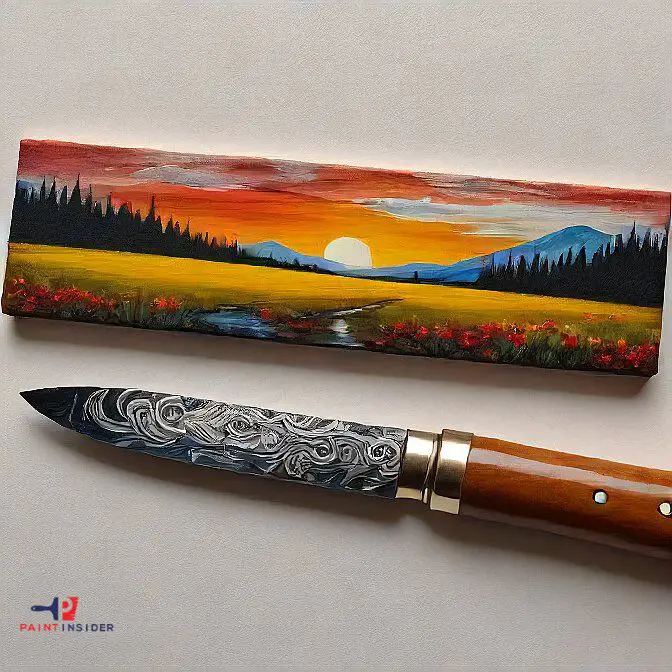Painting a knife blade adds a unique touch to your tool or collection. Whether to prevent rust, refresh its appearance, or add designs, proper techniques and materials are necessary for a smooth, lasting finish. This guide will walk you through prepping, painting, and sealing a knife blade for professional results. Let’s begin!
Introduction
How to paint a knife blade? It’s the question that comes to our minds. Similarly, many more questions like how to get the black finish on knife blades come to our mind. The idea of a back finish on the blades is the most demanding and attractive design. Because it not only looks fantastic but also prevents rust. It is pretty simple DIY to get that layer and also get a patina black finish. The method I’ll tell you is the best for carbon steel blade knives. If you have these knives in your collection, you’ll enjoy them. The process is incredible, and the supplies you need for this are also readily available. So, are you ready to start? Let’s proceed!
Preparing the Knife Blade Surface
Preparing the knife blade surface is a crucial step that can make or break your painting project. Before applying any paint, it’s essential to clean and smooth the blade thoroughly. Start by removing any grease or oils using a degreaser, as even a tiny residue can cause the paint to bubble or peel. Once cleaned, use fine-grit sandpaper to gently abrade the blade surface, creating a rougher texture for better paint adhesion. This unconventional yet effective method helps in forming micro-abrasions on the surface that enhance the grip of the coating.
Supplies Needed
- Cotton balls
- paper towels
- Silver polish
- Rubbing alcohol if it is not present, then you can also use ( naphtha or acetone)
- Apple cider vinegar or lime juice.
- tongs if you have not, you can also use large tweezers
Choosing the Right Paint Type
When it comes to choosing the right paint type, it’s essential to consider both the surface you’ll be painting and the intended use of that surface. For instance, if you’re looking to spruce up a knife blade say for an artistic display or a unique gift opting for paint designed specifically for metals is crucial. These paints often feature enhanced adhesion properties, allowing them to withstand wear and tear better than standard acrylic options, which might chip or peel over time.
Techniques for Applying Paint
When considering how to paint a knife blade, the technique is everything. One effective method involves using a high-quality spray paint designed for metal surfaces. Start by ensuring the blade is thoroughly cleaned and dried, removing any grease or grime that could interfere with adhesion. Hold the can about 8-12 inches away from the surface and apply light, even coats, allowing each layer to dry before adding another. This prevents drips and ensures a smooth finish that showcases your artistic flair.

For those seeking more control over their designs, using a fine-tipped brush can open up new avenues of creativity. Mixed media techniques can elevate your project; for instance, layering multiple colors or integrating textures like metallic flakes can produce stunning effects on the blade’s surface. Remember to seal your painted creation with a clear coat specifically formulated for metal this not only enhances durability but also brings out the vibrancy of the colors you’ve chosen. With these techniques in mind, painting knife blades transforms into an art form that merges aesthetic appeal with functionality.
Drying and Curing the Painted Blade
Once the paint has settled on your knife blade, drying and curing are important to keep your work intact. Instead of quickly putting it away, create a space with good airflow to avoid smudging or imperfections. The drying time varies by paint type; water-based paints dry faster but take longer to cure than solvent-based ones. You might want to use a small fan to help dry the paint evenly while thinking about how to improve your future painting sessions.
Curing the painted blade gives it a shiny finish and strong durability. Some may see curing as just waiting for paint to dry, but it also ensures good adhesion and lasting quality against wear and tear after all, it’s a tool, not just art! To boost resilience, gently buffing the surface after curing can add a professional shine. Keep in mind that each step after painting adds protection and a personal touch to your design. A canvas becomes a conversation starter with practical appeal!
Safety Precautions While Painting Knifes
When using painting knives, safety is crucial to avoid accidents and achieve the best results. Wear gloves to protect your hands from sharp edges and paint chemicals. A sturdy apron can keep your clothes safe from spills, especially with spray paint or acrylics that may splatter. Also, consider wearing a mask; it’s easy to forget when focusing on creativity, but it helps protect you from inhaling fumes and fine particles.
Conclusion: Enjoy Your Customized Knife Blade
Enjoying your customized knife blade comes from the bond you create with it. Each design and finish reflects your personality and creativity. Painting your knife blade can be a way to blend practicality with art. Picture using your custom-painted knife at a picnic; it’s not just useful, but also a conversation starter that highlights your unique style.

